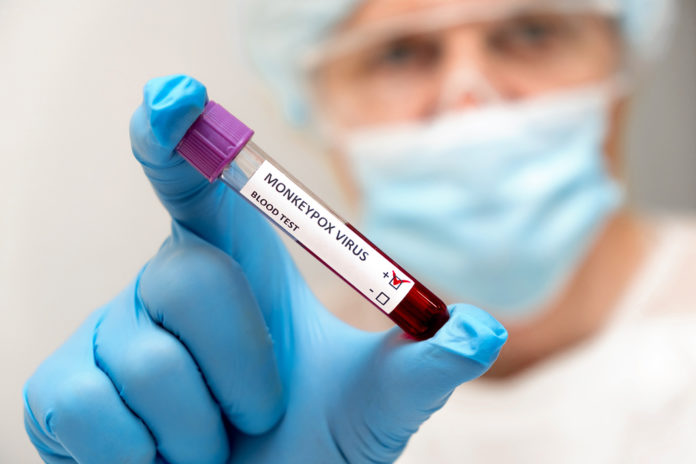
The Local newsletter is your free, daily guide to life in Colorado. For locals, by locals. Sign up today!
The COVID-19 pandemic still isn’t over, and the memories of lockdowns and ubiquitous messages encouraging social distancing are still fresh in everyone’s minds. So when the Biden administration declared monkeypox a public health emergency last week, it’s no surprise that Coloradans—and Americans in general—showed concern about another infectious disease crisis.
Monkeypox and COVID-19 are different in two very important ways: First, while COVID-19 is transmitted through airborne particles, monkeypox is usually spread through close contact. Second, although both can present with flulike symptoms, monkeypox comes along with painful blisters that can appear anywhere on the body, but especially in the genital and anorectal areas, as well as around the mouth.
As of early August, 91 cases of monkeypox had been reported in Colorado. We spoke with four providers and health officials to figure out what the monkeypox situation means for all of us.
Editor’s note: The following conversation has been edited for length and clarity.
5280: Monkeypox was first reported in humans 52 years ago. Why is it something we need to be concerned about now, seemingly all of the sudden?
Dr. Rachel Herlihy, Colorado’s state epidemiologist: We’re not really sure why now, but we do know how it got here. There are countries in central and western Africa where monkeypox is endemic, and cases pop up sporadically. We saw a rise of infections in European countries, followed by some in Canada, and ultimately there are now infections in the United States.
Dr. Daniel Pastula, neuro-infectious disease specialist, UCHealth University of Colorado Hospital: Monkeypox is what we call a zoonotic disease, meaning it can be spread between animals and people. Back in 2003, a shipment of pet prairie dogs [which were housed with infected rodents imported from Ghana] caused an outbreak in the United States. Since then, it’s really only been identified in central or western Africa. While the exact cause of this outbreak is unknown, it’s likely because of travel to and from those African countries where monkeypox is endemic.
How does the virus spread?
Dr. Sarah Rowan, infectious disease specialist, Denver Health: Close physical contact. That could be respiratory secretions, close skin-to-skin contact, or from touching a surface that was in contact with a monkeypox sore. All of those things could happen from a variety of activities, including (but not limited to) sex.
Tori Burket, epidemiology and disease intervention program manager, Denver Department of Public Health and Environment: Those lesions that people are developing is where we’re seeing the highest detectable viral load, so right now it’s mainly through direct contact with someone who has the lesions. If you hug, cuddle, kiss, have sex, or share clothing with someone who is infectious, you’re at risk of being infected. However, this isn’t like COVID-19. We haven’t seen a single case of someone developing monkeypox from, say, sitting next to someone on a plane.
What should we do if we think we have monkeypox symptoms?
Pastula: If you know you’ve had close contact with someone who has monkeypox, immediately isolate yourself and call your health care provider. The Jynneos vaccine can prevent monkeypox even after you’ve been exposed, but only before you start experiencing symptoms. If you’ve started experiencing symptoms, stay isolated at home until the blisters scab over and fall off, which usually takes two to four weeks. Also avoid touching your blisters—monkeypox can spread from one part of your body to another.
What do initial symptoms usually look like?
Pastula: Classically, flulike symptoms start first followed by pustules. In this outbreak, though, most people are reporting seeing a rash first, followed by those flat, red blisters, and then followed by flulike symptoms. Plus, those blisters can appear anywhere on the body, they don’t just appear on the genital or oral regions.
How do we know if a new sore is a monkeypox lesion or something else
Rowan: Monkeypox sores are usually less than a centimeter in length, have a dimple in the middle, and there’s a bit of a red base, but a lot of the sores can look different. They can look like pimples, shallow ulcers, or they can rupture and look like scabs. If you’re concerned about a new sore, contacting your primary provider is usually your best bet.
Burket: For many people, it’s incredibly difficult to tell. We’ve seen monkeypox legions have that typical “pox” look, but others can look like pimples or ingrown hairs. Our main message is if people have anything that they think is unusual, there’s nothing wrong with calling your health care provider. Plus, if it’s not monkeypox, your provider can help you figure out what else it could be.
How do we best protect ourselves?
Burket: Wearing a mask is a really great way to reduce the risk from a lot of illnesses, COVID-19 and the flu included, but it’s not the first line of defense from monkeypox. We don’t recommend abstinence, but if people have multiple sexual partners who they don’t know, we recommend exchanging contact information so you can contact those people later on in the case of symptoms. People may also consider limiting or reducing the number of partners they have and having honest conversations with their partners if they have any new skin lesions.
This outbreak feels uncomfortably like déjà vu coming on the heels of COVID-19. Do you foresee this being another pandemic with shutdowns?
Rowan: COVID-19 and monkeypox are so different. Not only are the rates of transmission with monkeypox less severe, but death from monkeypox is also extremely rare. Most people with monkeypox have symptoms that can be resolved at home within a couple of weeks without professional treatment. I don’t see a need for any shutdowns.
Pastula: The R-value, or reproductive number, with monkeypox is a lot lower than it is with COVID-19, meaning monkeypox is not as easily transmissible as COVID-19. I don’t think we’ll see the same response towards monkeypox, but regardless this is a serious disease. I think this shows that we need to have a robust public health system, because these diseases are always a threat, and we need to be better prepared to handle them.
What’s the greater threat right now, COVID-19 or monkeypox?
Herlihy: It’s challenging to say. We’re still seeing way more COVID-19 infections than monkeypox infections, but monkeypox is definitely a new challenge. We already knew about monkeypox, and we have a vaccine for it, so it feels like we’re starting from a different place than we did with COVID-19.
What else should we know?
Rowan: Monkeypox so far, has been most prevalent among gay and bisexual men. We are trying to be proactive with those groups to minimize transmission, just because that’s where we’re seeing the most transmission, but we absolutely do not want this to be stigmatized like it was during the HIV/AIDS crisis. Gay and bisexual men are not the only groups that can get monkeypox—we’ve also seen women, children, and heterosexual men become infected.
Herlihy: There’s a vaccine out right now called Jynneos, but supplies are limited. Right now, those prioritized for the vaccine are those who’ve had multiple sexual partners or anonymous sexual partners. Additionally, if you know you’ve had contact with someone with monkeypox, contact your provider immediately to try to get a preventive vaccine. Once you start experiencing symptoms, it’s too late.
For more information on monkeypox, and resources on testing and vaccination, visit the Denver Department of Public Health, the Colorado Department of Public Health and Environment, or the CDC.








